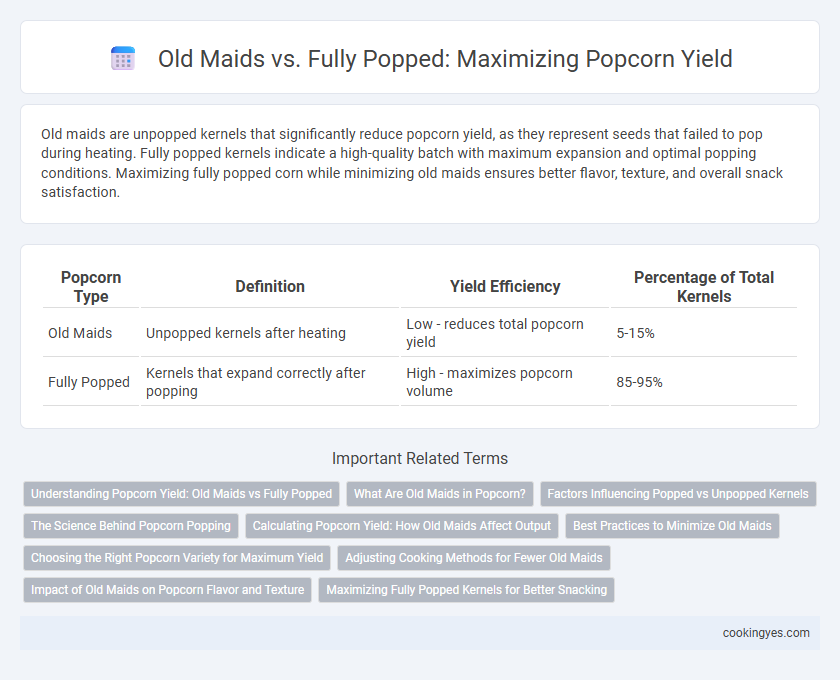Old maids are unpopped kernels that significantly reduce popcorn yield, as they represent seeds that failed to pop during heating. Fully popped kernels indicate a high-quality batch with maximum expansion and optimal popping conditions. Maximizing fully popped corn while minimizing old maids ensures better flavor, texture, and overall snack satisfaction.
Table of Comparison
| Popcorn Type | Definition | Yield Efficiency | Percentage of Total Kernels |
|---|---|---|---|
| Old Maids | Unpopped kernels after heating | Low - reduces total popcorn yield | 5-15% |
| Fully Popped | Kernels that expand correctly after popping | High - maximizes popcorn volume | 85-95% |
Understanding Popcorn Yield: Old Maids vs Fully Popped
Popcorn yield is significantly affected by the ratio of old maids to fully popped kernels, with old maids representing unpopped kernels that reduce overall volume. Fully popped kernels maximize yield due to their expanded size, typically achieving a popcorn yield of 35-40 times their original kernel volume. Monitoring factors like kernel moisture content and proper popping temperature helps minimize old maids and optimize popcorn yield for better snack quality and quantity.
What Are Old Maids in Popcorn?
Old maids in popcorn are unpopped kernels that fail to burst during cooking due to insufficient moisture or kernel hardness. They reduce the overall popcorn yield by occupying space without contributing to the fluffy, edible portion. Understanding the factors behind old maids helps improve popping efficiency and maximize popcorn output.
Factors Influencing Popped vs Unpopped Kernels
Popcorn yield is significantly impacted by the moisture content within each kernel, where an ideal range of 13-14% ensures maximum expansion and minimizes old maids--unpopped kernels resulting from insufficient internal steam pressure. Kernel size and hull integrity also play crucial roles; smaller or damaged kernels often fail to fully pop, leading to higher unpopped rates. Proper storage conditions that maintain kernel moisture and avoid mechanical damage are essential to optimizing the ratio of fully popped popcorn to old maids.
The Science Behind Popcorn Popping
Old maids, or unpopped kernels, result from insufficient moisture inside the popcorn kernel, preventing the buildup of steam pressure needed to explode the hull. Fully popped popcorn achieves optimal yield because kernels contain around 14% moisture, creating intense internal pressure that causes the starchy interior to gelatinize and expand rapidly. The science behind popcorn popping relies on the precise balance of moisture content, kernel structure, and heat, which determines whether a kernel becomes an old maid or successfully pops.
Calculating Popcorn Yield: How Old Maids Affect Output
Calculating popcorn yield requires differentiating between fully popped kernels and old maids, the unpopped or partially popped kernels that reduce overall output. Old maids account for a loss in edible volume, often representing 5-10% of the total kernels, which directly impacts yield efficiency. Accurately measuring popcorn yield involves subtracting the weight or count of old maids from total kernels, optimizing cooking techniques to minimize their occurrence and maximize popped volume.
Best Practices to Minimize Old Maids
Maximizing popcorn yield involves reducing old maids--unpopped kernels that result from uneven heating or moisture levels below 13.5%. Maintaining consistent kernel moisture, using high-quality popping oils with stable smoke points, and precise temperature control between 180-190degC effectively minimize old maids. Regularly shaking the popping vessel ensures even heat distribution, preventing kernel scorching and promoting a fully popped batch with optimal expansion.
Choosing the Right Popcorn Variety for Maximum Yield
Old maids, or unpopped kernels, reduce overall popcorn yield by occupying space without expanding, directly impacting batch efficiency. Selecting popcorn varieties with higher hull integrity and moisture content, such as mushroom or butterfly kernels, can significantly increase the percentage of fully popped kernels. Optimizing yield requires balancing seed characteristics and storage conditions to minimize old maids while maximizing volume and fluffiness.
Adjusting Cooking Methods for Fewer Old Maids
Old maids, unpopped kernels, reduce popcorn yield and indicate uneven heat distribution or moisture content. Adjusting microwave power, extending cooking time, or pre-soaking kernels can significantly decrease old maid occurrence for maximum popcorn volume. Consistent kernel quality and optimal stirring also enhance popping efficiency and minimize leftover unpopped kernels.
Impact of Old Maids on Popcorn Flavor and Texture
Old maids, unpopped kernels, significantly reduce popcorn yield by occupying space without contributing to volume. Their presence impacts overall flavor by causing uneven heating, leading to burnt or undercooked popcorn, which diminishes texture quality. Ensuring minimal old maids promotes a consistently crispy, fully popped batch with optimal flavor and mouthfeel.
Maximizing Fully Popped Kernels for Better Snacking
Maximizing fully popped kernels increases popcorn yield, reducing old maids--unpopped kernels that lower snack quality and portion size. Proper moisture content around 13-14% and optimal popping temperature near 180degC enhance kernel expansion and minimize unpopped remnants. Using high-quality hybrid popcorn varieties further boosts fully popped percentages, creating a better snacking experience with more fluffy, edible corn.
Old maids vs Fully popped for popcorn yield Infographic

 cookingyes.com
cookingyes.com